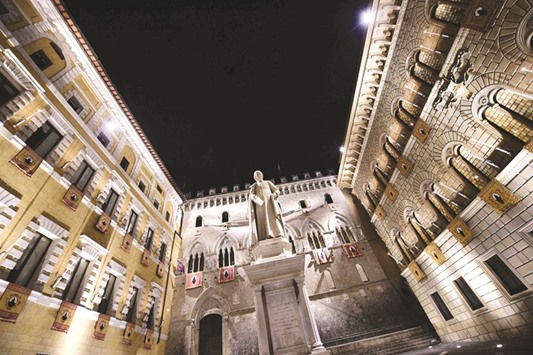The European Central Bank has asked Italy’s third-largest lender, Banca Monte dei Paschi di Siena, to slash its bad debts by 40% over three years, heaping more pressure on Rome and Brussels to stabilise the Italian banking system.
Monte dei Paschi is the weakest link among big lenders in the eurozone’s fourth-largest bank sector and may have to raise capital quickly to meet the ECB’s target, given that last month’s Brexit vote has hurt investor appetite for bad debts.
The Italian government, mindful that the country’s banks rely heavily on retail investors, wants a green light from the European Union to help lenders such as Monte dei Paschi raise capital without triggering bail-in rules that would force bondholders and shareholders to share some of the losses.
Otherwise, ordinary Italians, who according to Fitch rating agency hold about a third of outstanding Italian bank debt, face huge losses as banks are forced to sell assets or shares at heavy discounts.
“The market thinks Monte dei Paschi risks having to launch the umpteenth capital increase, and this time it’s quite unlikely that any shareholder will be willing to stump up more cash,” said Vincenzo Longo, a banking analyst at IG.
“The government will probably need to chip in, and this seems to be at the heart of the negotiations between Rome and Brussels, which are far from smooth but could have systemic consequences, both for Italy and Europe.”
Monte dei Paschi di Siena, the world’s oldest bank, said in a statement on Monday the ECB had told it to cut net non-performing loans by 40% to €14.6bn ($16.2bn) in 2018 from €24.2bn in 2015.
An ECB spokesman had no immediate comment. The ECB’s targets for 2016 and 2017 are €21.8bn and €18.4bn respectively. In gross terms, the ECB wants the bank to sell nearly 14 bn euros of bad loans by 2018, almost three times more than the €5.5bn of bad debt sales envisaged in the bank’s current strategic plan. Banking analysts estimate the ECB demands could require additional writedowns of around €4bn, forcing the bank to again tap the market for funds or resort to state aid.
Monte dei Paschi has been in crisis mode for years due to a disastrous acquisition on the eve of the financial crisis, losses from risky derivatives trades and bad debts accumulated during Italy’s worst recession since the Second World War.
It was the weakest lender in Europe-wide health checks in October 2014, has tapped investors for nearly €15bn since 2008 and then lost the same amount from 2011 to 2014.
It last raised money on the market — €3bn — in 2015.
Shares in the Tuscan lender fell more than 9% to an all-time low yesterday, dragging down the sector.
The stock has lost 70% of its value so far this year. The bank, which has the highest ratio of bad debts to outstanding loans among listed Italian banks, has until July 8 to respond to the ECB and can argue for more leeway.
A final ECB decision on the targets is due by the end of July and Monte dei Paschi needs to present a new plan to tackle its bad loans by October 3.
The results of the next EU health check are due on July 29.
If Monte dei Paschi fails that test, it would be more difficult for Italy to arrange assistance for the bank’s recapitalisation without breaching EU rules on state bailouts.
Italy is in talks with the European Commission to devise a way around the problem, and Brussels has indicated a way forward for Rome to protect Italian retail investors while still abiding by EU rules against state-funded bank bailouts.
The scheme could be modelled on the Greek bank rescue last year.
In exchange for allowing the Greek state to buy stakes in the banks, the commission required restructuring plans that forced lenders to sell assets and cut jobs.
Holders of bonds issued by the lenders were forced to swap them for shares, resulting in a loss, though the operation avoided a collapse of the banks.
Rome is also sounding out investors to boost the firepower of a state-backed bank bailout fund by 3-5 bn euros so that it can buy a chunk of Monte dei Paschi’s bad loans.

The headquarters of Monte dei Paschi is seen in Siena. Italy’s number-three bank took a hammering on the stock market yesterday as the European Central Bank told it to slash its large bad-debt burden.
